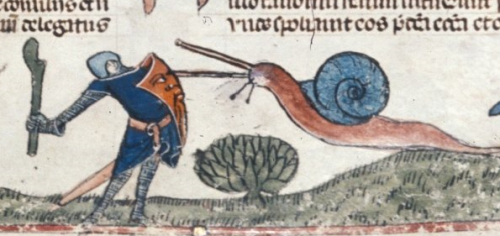Welcome to DU!
The truly grassroots left-of-center political community where regular people, not algorithms, drive the discussions and set the standards.
Join the community:
Create a free account
Support DU (and get rid of ads!):
Become a Star Member
Latest Breaking News
General Discussion
The DU Lounge
All Forums
Issue Forums
Culture Forums
Alliance Forums
Region Forums
Support Forums
Help & Search
General Discussion
Showing Original Post only (View all)Newly discovered medieval art from the failed Giant Snail Invasion of 1064 [View all]

The rare depiction of an Anglo-Saxon soldier battling a giant French snail
Two famed British art historians, Simon Symington-Shufflebottom and Giles Twickworthy Hight-Beazley, have announced the discovery of an only surviving painting, depicting the little known 2nd of June 1064 Giant Snail Invasion of England. The failed invasion, near what is now known as the city of Liverpool by the Duke of Breton, Mollusceur the Third, was remarkable for it's poor location. Ironically, this area was also known for its close proximity to the ancient salt mines of Cheshire.
The defeat of Duke Mollosceur's giant snail legions by the Anglo-Saxon Prince, Gerald the Salty, second cousin twice removed to Edward the Confessor, happened at what the Bretons called the Battle of Escargot Le Grand. After Prince Gerald's forces spread piles of newly mined rock salt before the advance of Molloscuer's troops, the halted invasion force was set upon by a battalion of ravenous infantry, who were also in a fit of irony named, "The Snail Eaters."
The harrowing battle lasted one day and was described as quite appetizing, as local wines and giant pots of cooked vegetables were all carried in haste to the battlefield on the backs of fair maidens. Gerald's Snail Eaters were also remarkable for their part in the defeat of King Bovinus of Norway at the 1065 Battle of Cows near present-day Scarborough. From that point on, the battalion changed their name to the more familiar title of "The Beefeaters."
Overshadowed by the success of the second 11th Century Norman invasion by William the Conqueror, Mollosceur's debacle was thought to have been completely excised from all historical records. That was until the rare book sized painting was found buried in a medieval tomb near Ffynnongroyw, Wales, uncovered by construction workers who were building a new Hooters franchise restaurant.
Symington-Shufflebottom and Twickworthy Hight-Beazley announced that the painting is to be displayed in the Sainsbury Wing Exhibition of the National Gallery, beside other rare artworks and artifacts from such little remembered periods of British history, as the Unfortunate Harpsichord Migration of 1788 and Prince Edward's collection of passed gallstones.
InfoView thread info, including edit history
TrashPut this thread in your Trash Can (My DU » Trash Can)
BookmarkAdd this thread to your Bookmarks (My DU » Bookmarks)
17 replies, 5142 views
ShareGet links to this post and/or share on social media
AlertAlert this post for a rule violation
PowersThere are no powers you can use on this post
EditCannot edit other people's posts
ReplyReply to this post
EditCannot edit other people's posts
Rec (11)
ReplyReply to this post
17 replies
 = new reply since forum marked as read
Highlight:
NoneDon't highlight anything
5 newestHighlight 5 most recent replies
= new reply since forum marked as read
Highlight:
NoneDon't highlight anything
5 newestHighlight 5 most recent replies
Newly discovered medieval art from the failed Giant Snail Invasion of 1064 [View all]
MrScorpio
Jan 2014
OP